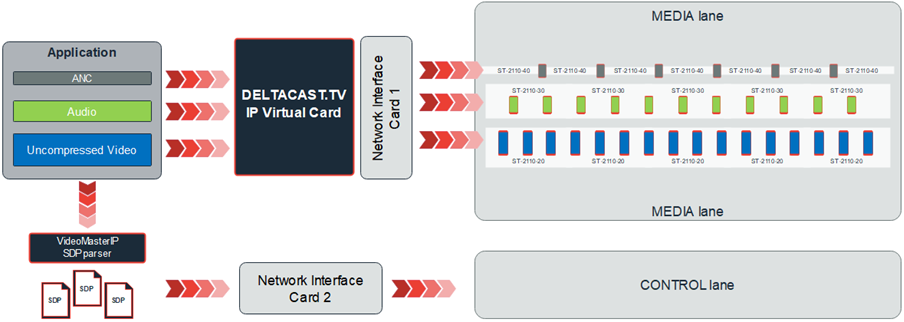What is SMPTE 2110 ?
ST 2110 is a family of protocols defined by the SMPTE consortium to provide an IP
streaming alternative to historical SDI (Serial Digital Interface) connectivity used in broadcast infrastructures.
The SMPTE 2110 ecosystem includes the following standards :
- ST 2110-10 : System Timing and Definitions
- ST 2110-20 : Uncompressed Active Video
- ST 2110-21 : Traffic Shaping and Delivery Timing for Video
- ST 2110-22 : Constant Bit-Rate Compressed Video
- ST 2110-30 : PCM Digital Audio
- ST 2110-31 : AES3 Transparent Transport
- ST 2110-40 : SMPTE ST 291-1 Ancillary Data
SMPTE 2110 relies on streaming the different elementary flows – called essences – of a multimedia feed through separate, synchronized, RTP streams.

RTP (Real-Time Transport Protocol, as defined in IETF RFC 3550) is a packet-based multimedia streaming solution built on top of UDP.

The different essences and streams are synchronized together thanks to timestamps sampled on a common clock shared in the infrastructure thanks to PTP (Precision Time Protocol, as defined in IEEE 1588 and adapted to broadcast needs through SMPTE ST 2059-2).
Why migrating from SDI to IP ?
The broadcast industry is operating a significant transition, with the move away from baseband video to adopt IP-based video contribution workflows.
This transition is not only about technological challenges, but also about opening doors to new ways of working, to closer collaborations between different TV production departments, and to innovative economic models.
The move to IP also encourages the migration from dedicated electronics to computer-based systems, to IT-centric intrastructures, and to datacenter implementations.

IP infrastructures have been used for years in broadcast distribution premises, where compressed video usage reduces the throughput needs to affordable figures. Cable headends are used to work with SMPTE 2022-1/2 setups.
Using IP infrastructures for the TV production, where an optimal picture quality is essential, is now a technical reality thanks to increasing network bandwidths and computer processing power.
Nowadays, 10, 25, 100, 200GbE connections allow to effortlessly carry on several uncompressed feeds in 1080p, 4K and even 8K!
By using visually lossless codecs, network links usage can even be further optimized.
The IP ecosystem around SMPTE 2110
The SMPTE defines and publishes the complete set of ST 2110 norms.
Prior to that, SMPTE published ST 2022-6, another RTP-based standard for carrying on uncompressed SDI video, and now specified bridges to convey ST 2022-6 onto ST 2110 networks.
These streaming standards are based on technical recommendations issued by VSF (the Video Services Forum).
Being essentially streaming protocols and standards, SMPTE ST 2022-6 and ST 2110 implementations also rely on the NMOS (Networked Media Open Specifications) family of norms, written by the AMWA organization, to deal with network management and security. The NMOS specifications is a fast-evolving set of standards, currently including :
- IS-04 : Discovery & Registration
- IS-05 : Device Connection Management
- IS-07 : Event & Tally
- IS-08 : Audio Channel Mapping
- IS-09 : System Parameters
- IS-10 : Authorization
On top of those organizations, the AIMS alliance promotes the adoption of these new standards within the industry.
All these groups activities are surrounded by the JT-NM (Joined Task Force on Networked Media) that also insures products compliance through the JT-NM Tested program, successfully passed by several DELTACAST products.
DELTACAST IP Solutions
Addressing new standards at the soonest is a key element of DELTACAST strategy, and the objective is to provide customers with the smoothest transition from an ecosystem to another one.
Historically designing PCI Express video cards, DELTACAST also introduced models dedicated to IP video streaming. Besides that, in line with the migration to software-based workflows occurring in parallel of the IP transition, DELTACAST also comes with an innovative software solution.
I/O Cards
The DELTA-ip-ST2110 10 and DELTA-ip-ST2110 01 are dual 10GbE interface card that support SMPTE ST 2110 video, audio and ancillary data streams in reception and transmission.
The cards also implement SMPTE ST 2022-7 seamless protection switching mechanism (redundant streams).
Since May 2020, DELTACAST ST2110 reception and transmission products successfully obtained the “Self-Tested in Accordance with JT-NM Test Plan for SMPTE ST 2110” badge!
If needed these cards can also be reconfigured to DELTA-ip-ST2022-6 10 & DELTA-ip-ST2022-6 01, which are dual 10GbE interface card that support SMPTE ST 2022-6 "SDI over IP" reception and transmission, SMPTE ST 2022-5 Forward Error Correction and SMPTE ST 2022-7 seamless protection switching mechanism.
Software stack
The IP Virtual Card is a software framework dedicated to high-performance video streaming over COTS network cards.
Designed from the ground up to allow high-performances multimedia capture and streaming using an off-the-shelf network card, the current version of the IP Virtual Card targets SMPTE ST 2110 connectivity.
The IP Virtual Card brings in support for video transport as per ST 2110-20 and ST 2110-22, audio transport as per ST 2110-30, and ancillary data transport as per ST 2110-40. It also includes a PTP synchronization solution compliant to ST 2059. The solution also supports ST 2022-7 redundancy in reception and transmission. Thanks to an optimized network stack, the IP Virtual Card insures accurate, PTP locked, media streams compliant to ST2110-21 Type W and even Type NL senders, and it allows implementing ST2110-21 Type A receivers.
The IP Virtual Card implements an optimized network stack based on the operating system sockets, so that it is compatible with any NIC brand and model, and so that it can be used under Windows and Linux, and also targeting virtualization environments and execution in containers. For most demanding applications, the IP Virtual Card also exists in a version based on the popular DPDK kernel bypass currently available for Linux.
What else?
To offer a complete and robust NMOS solution to manufacturers developing IP media servers and applications based on the IP Virtual Card and VideoMasterIP SDK, DELTACAST wrote various ST2110 Media Nodes code examples based on the Sony nmos-cpp implementation.
The media node examples are provided open-source and hosted on the DELTACAST GitHub repository.
They demonstrate the design of a ST2110 video emitter node and of a ST2110 receiver node offering the support for :
- IS-04 Discovery and Registration, through the use of the NodeAPI
- IS-05 Device Connection Management, through the use of the ConnectionAPI
- IS-09 System Parameters, through the use of the SystemAPI
Like the IP Virtual Card, the NMOS code examples are cross-compatible with Windows and Linux.
Transition to IP video streaming is underway in multiple industries and sectors, which see lots of different emerging norms and technologies.
Do not hesitate to let us know if you have specific needs besides SMPTE ST 2110, with protocols like :
- IPMX (Internet Protocol Media eXperience) : based on ST 2110 and introduced by AIMS to address the ProAV industry
- NDI : proprietary solution based on compressed video and automatic discovery
- SRT (Secure Reliable Transport) : open-source streaming protocol focusing on the video transport over unsecure and unpredictable network, and hence over the public Internet
- RIST (Reliable Internet Stream Transport) : an open source, open specifications, streaming protocol developed and promoted by VSF (Video Service Forum) to address video transport over the public Internet









